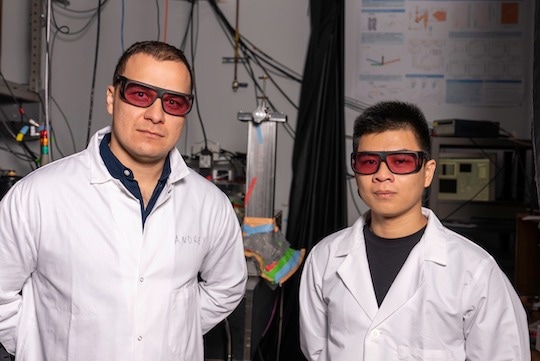Improved thermal conductivity in materials is essential for creating cutting-edge electronics that support applications in clean energy, communications, and aircraft.
 Andrey Baydin (left) and Fuyang Tay. Image Credit: Gustavo Raskosky/Rice University
Andrey Baydin (left) and Fuyang Tay. Image Credit: Gustavo Raskosky/Rice University
However, scientists must comprehend the behavior of phonons - quantum units of atomic vibration - in a given material to create materials with this feature.
Phonons are quite important for studying new materials because they govern several material properties such as thermal conductivity and carrier properties. For example, it is widely accepted that superconductivity arises from electron–phonon interactions. Recently, there has been growing interest in the magnetic moment carried by phonon modes that show circular motion, also known as chiral phonons. But the mechanisms that can lead to a large phonon magnetic moment are not well understood.
Fuyang Tay, Graduate Student, Applied Physics, Rice University
Fuyang Tay works with the Rice Advanced Magnet with Broadband Optics (RAMBO), a tabletop spectrometer in Junichiro Kono’s laboratory.
An international team of researchers, led by Andrey Baydin, an Assistant Research Professor at Rice University, and Felix Hernandez of the Universidade de São Paulo in Brazil, has now published a study that explains the intricate relationships between the electronic band structure of a material, which determines the range of energy levels that electrons can have within it, and the magnetic properties of these quantum whirling dervishes.
This discovery broadens the understanding of phonons and presents opportunities for the creation of improved materials as well as more efficient phonon manipulation using magnetic fields.
Lead telluride is a straightforward semiconductor that was subjected to a magnetic field in a prior investigation by Baydin and associates. After the completion, the scientists noticed that the phonons had changed from linear to chiral, moving in a circle.
Chiral phonons interact with one another differently than phonons that move linearly. If we understood the properties of these interactions, we could make use of them. Different properties could realize different potential applications in materials.
Andrey Baydin, Department of Electrical and Computer Engineering, Rice University
Observing that the magnetic moment of chiral phonons is rather tiny in the material when studied initially, the researchers questioned if altering the material’s electronic band structure or topology can affect its magnetic properties. The researchers placed a novel substance known as a crystalline topological insulator to the test to find an answer.
We took the lead telluride and added tin to it. If you add enough, something called band inversion happens, creating topologically protected surface states. These materials are fascinating because they are insulating in bulk but have conducting electronic surface states - a very promising feature that could be exploited in novel electronic devices.
Andrey Baydin, Department of Electrical and Computer Engineering, Rice University
Further experiments demonstrated that the magnetic moment of the chiral phonons was notably larger—two orders of magnitude—in the topological material compared to the material lacking this specific electronic topology.
Baydin says, “Our findings reveal compelling new insights into the magnetic properties of phonons in this material and emphasize the intricate connection between the magnetic properties of chiral phonons and the material’s underlying electronic band structure topology.”
He emphasized their intention to carry out additional experiments aimed at gaining a deeper comprehension of various aspects of phonon behavior in forthcoming studies.
Tay adds that these results, which explain that the magnetic moment of phonons is significantly improved in topological materials, can assist materials scientists in searching and designing materials with larger phonon magnetic moments as required for various device applications.
Tay continues, “This observation provides new insights into how to control and manipulate phonon properties to change thermal conductivity. Furthermore, the interplay between chiral phonons and electronic structure topology raises the possibility that the topological phase could be influenced by controlling the phonons.”
The research is funded by the National Science Foundation, Rice University through the Brasil@Rice Collaborative Grant, the São Paulo Research Foundation, Brazil’s National Council for Scientific and Technological Development, the Alexander von Humboldt Foundation, and the Japan Society for the Promotion of Science.
Journal Reference:
Felix G. G. Hernandez, G, G, F., et al. (2023). Observation of interplay between phonon chirality and electronic band topology. Science Advances. doi/10.1126/sciadv.adj4074.